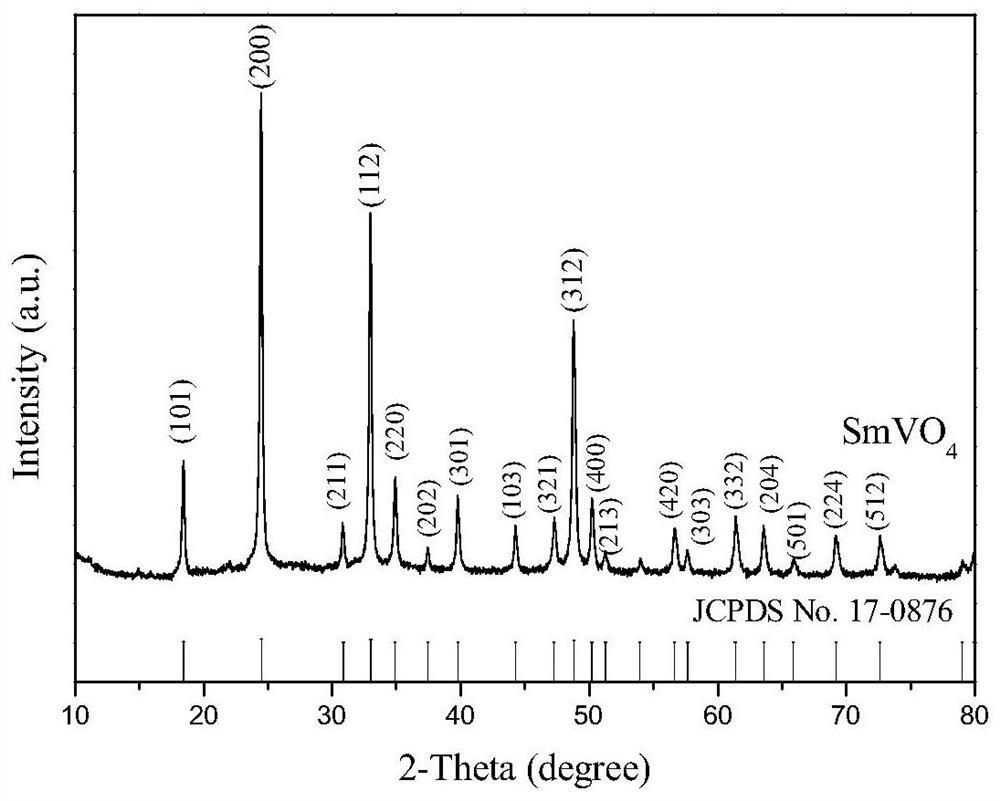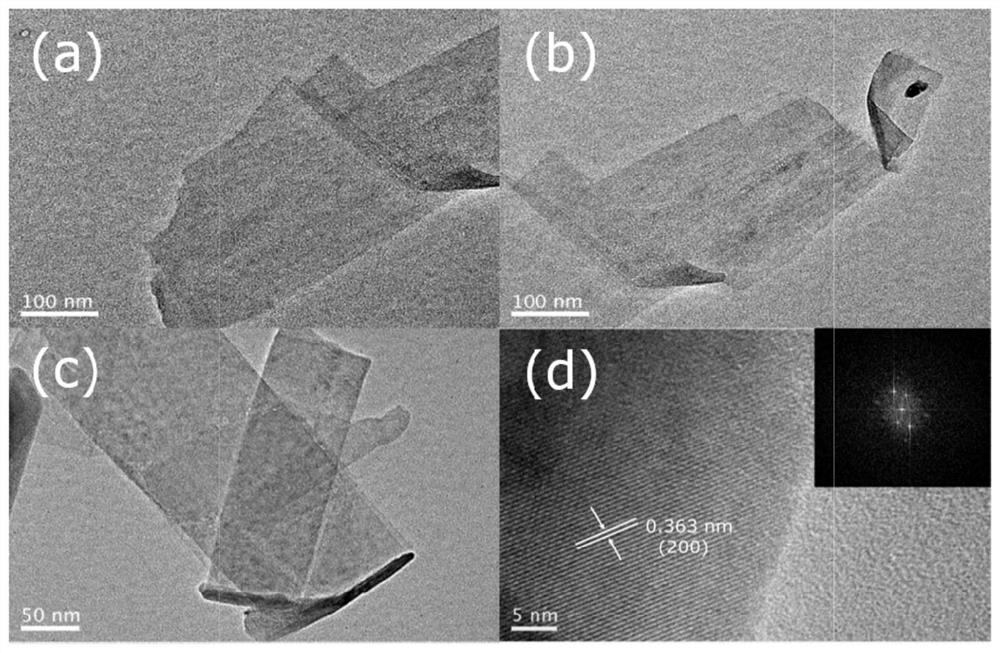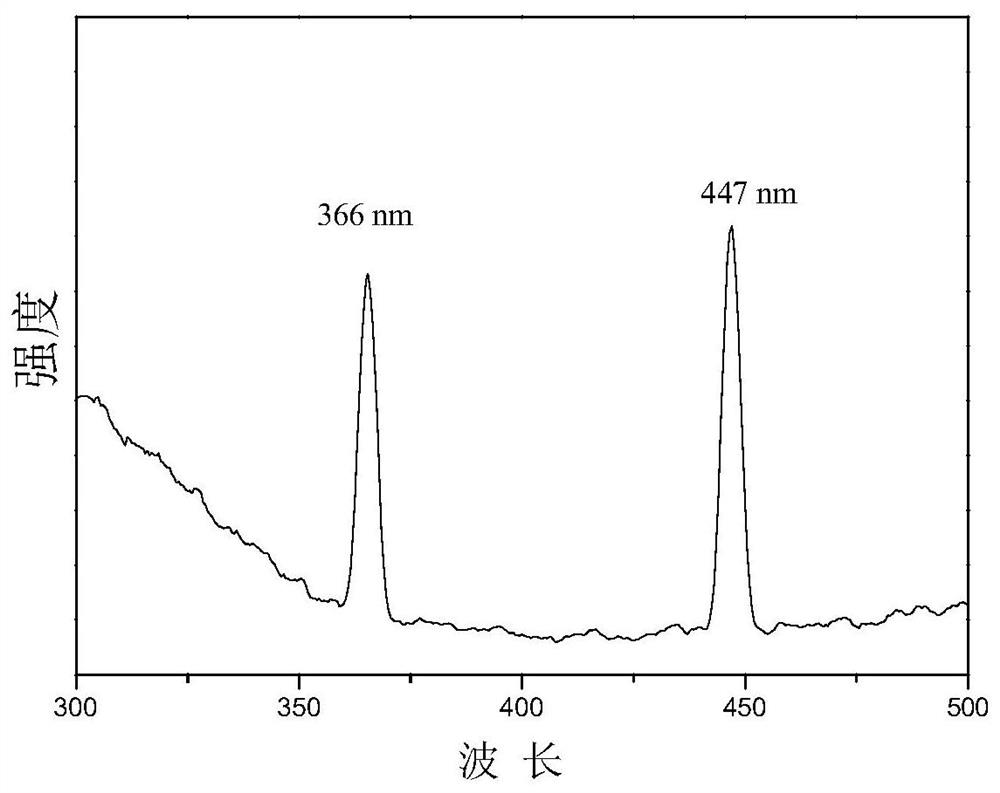Preparation method and application of rare earth vanadate two-dimensional nanosheet photocatalytic material
A rare-earth vanadate and two-dimensional nanotechnology, which is applied in the preparation/separation of ammonia, chemical instruments and methods, and catalysts for physical/chemical processes, etc., to achieve small band gap, excellent performance, and favorable light penetration Effect
- Summary
- Abstract
- Description
- Claims
- Application Information
AI Technical Summary
Problems solved by technology
Method used
Image
Examples
Embodiment 1
[0026] 100mL of Sm(NO 3 ) 3 ·6H 2 O and NH 4 VO 3 Mix in deionized water (both concentrations are 0.001mol / L), ultrasonicate until completely dissolved, add 0.001mol organic template polyvinylpyrrolidone under heating and magnetic stirring conditions, and adjust the pH of the solution to 1 with hydrochloric acid, and then mix the solution Transfer to a sealed Teflon autoclave and react at 120°C for 2 hours under microwave hydrothermal conditions. After naturally cooling to room temperature, the resulting precipitate was collected by centrifugation and washed several times with deionized water. Finally, dry at 80°C for 12 hours to obtain SmVO 4 Two-dimensional nanosheet materials.
[0027] figure 1 is SmVO 4 The XRD patterns and SmVO 4 PDF card (JCPDS No.17-0876). It can be seen from the figure that the three strong peaks at 2θ = 24.9°, 33.2°, 48.6° correspond to SmVO 4 The (200), (112), (312) planes determine the SmVO 4 the existence of species. In addition, there...
Embodiment 2
[0032] 100mL of Ce(NO 3 ) 3 ·6H 2 O and NH 4 VO 3Mix in deionized water (both concentrations are 0.1mol / L), ultrasonicate until completely dissolved, add 0.01mol organic template polyvinylpyrrolidone under heating and magnetic stirring conditions, and adjust the pH of the solution to 4 with nitric acid, and then mix the The solution was transferred to a sealed Teflon autoclave, and reacted for 1 hour under the condition of microwave hydrothermal heating at 180°C. After naturally cooling to room temperature, the resulting precipitate was collected by centrifugation and washed several times with deionized water. Finally, dry at 80°C for 12 hours to obtain CeVO 4 Two-dimensional nanosheet materials.
[0033] The invention also provides the above material for photocatalytic synthesis of ammonia. Under full-spectrum irradiation of 300W xenon lamp, CeVO 4 The ammonia yield of nanosheets reached 116umolg -1 h -1 , under the irradiation of near-infrared light after 780nm, Ce...
Embodiment 3
[0035] 100mL of Pr(NO 3 ) 3 ·6H 2 O and NH 4 VO 3 Mix in deionized water (both concentrations are 0.01mol / L), ultrasonicate until completely dissolved, add 0.005mol organic template polyvinylpyrrolidone under heating and magnetic stirring conditions, and adjust the pH of the solution to 3 with nitric acid, and then mix the The solution was transferred to a sealed Teflon autoclave, and reacted for 1.5 hours under the condition of microwave hydrothermal heating at 140°C. After naturally cooling to room temperature, the resulting precipitate was collected by centrifugation and washed several times with deionized water. Finally, dry at 80°C for 12 hours to obtain PrVO 4 Two-dimensional nanosheet materials.
[0036] The invention also provides the above material for photocatalytic synthesis of ammonia. Under the full spectrum irradiation of 300W xenon lamp, PrVO 4 The ammonia yield of nanosheets reached 112umolg -1 h -1 , under the irradiation of near-infrared light after...
PUM
 Login to View More
Login to View More Abstract
Description
Claims
Application Information
 Login to View More
Login to View More - R&D
- Intellectual Property
- Life Sciences
- Materials
- Tech Scout
- Unparalleled Data Quality
- Higher Quality Content
- 60% Fewer Hallucinations
Browse by: Latest US Patents, China's latest patents, Technical Efficacy Thesaurus, Application Domain, Technology Topic, Popular Technical Reports.
© 2025 PatSnap. All rights reserved.Legal|Privacy policy|Modern Slavery Act Transparency Statement|Sitemap|About US| Contact US: help@patsnap.com



